Related Research Articles
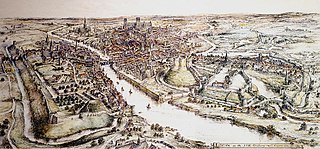
A motte-and-bailey castle is a European fortification with a wooden or stone keep situated on a raised area of ground called a motte, accompanied by a walled courtyard, or bailey, surrounded by a protective ditch and palisade. Relatively easy to build with unskilled labour, but still militarily formidable, these castles were built across northern Europe from the 10th century onwards, spreading from Normandy and Anjou in France, into the Holy Roman Empire, as well as the Low Countries it controlled, in the 11th century, when these castles were popularized in the area that became the Netherlands. The Normans introduced the design into England and Wales. Motte-and-bailey castles were adopted in Scotland, Ireland, and Denmark in the 12th and 13th centuries. By the end of the 13th century, the design was largely superseded by alternative forms of fortification, but the earthworks remain a prominent feature in many countries.
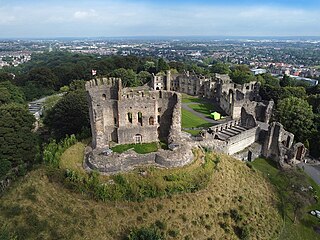
Dudley Castle is a ruined fortification in the town of Dudley, West Midlands, England. Originally a wooden motte and bailey castle built soon after the Norman Conquest, it was rebuilt as a stone fortification during the twelfth century but subsequently demolished on the orders of Henry II of England. Rebuilding of the castle took place from the second half of the thirteenth century and culminated in the construction of a range of buildings within the fortifications by John Dudley. The fortifications were slighted by order of the Parliament of England during the English Civil War and the residential buildings destroyed by fire in 1750. In the nineteenth and early twentieth century the site was used for fêtes and pageants. Today Dudley Zoo is located on its grounds.

Cambridge Castle, locally also known as Castle Mound, is located in Cambridge, Cambridgeshire, England. Originally built after the Norman conquest to control the strategically important route to the north of England, it played a role in the conflicts of the Anarchy, the First and Second Barons' Wars. Hugely expanded by Edward I, the castle then fell rapidly into disuse in the late medieval era, its stonework recycled for building purposes in the surrounding colleges. Cambridge Castle was refortified during the English Civil War but once again fell into disuse, used primarily as the county gaol. The castle gaol was finally demolished in 1842, with a new prison built in the castle bailey. This prison was demolished in 1932, replaced with the modern Shire Hall, and only the castle motte and limited earthworks still stand. The site is open to the public daily and offers views over the historic buildings of the city.

Skipsea Castle was a Norman motte and bailey castle near the village of Skipsea, East Riding of Yorkshire, England. Built around 1086 by Drogo de la Beuvrière, apparently on the remains of an Iron Age mound, it was designed to secure the newly conquered region, defend against any potential Danish invasion and control the trade route across the region leading to the North Sea. The motte and the bailey were separated by Skipsea Mere, an artificial lake that was linked to the sea during the medieval period via a navigable channel. The village of Skipsea grew up beside the castle church, and the fortified town of Skipsea Brough was built alongside the castle around 1160 to capitalise on the potential trade.

Aslockton Castle is a ruined fortification, a motte-and-bailey castle, in the village of Aslockton, Nottinghamshire. The original name of the settlement was Aslachetone, which suggests a possible Norse origin; it was mentioned in the Domesday Book of 1086 where it was described as a large settlement.

Bakewell Castle was in the town of Bakewell, Derbyshire.
Eardisley Castle was in the village of Eardisley in Herefordshire, England, 11 km north-east of Hay-on-Wye. The site of the castle is a scheduled monument.
Ely Castle was in the cathedral city of Ely in Cambridgeshire. Its probable site is a mound near the cathedral which is now called Cherry Hill.
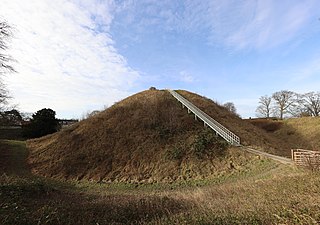
Thetford Castle is a medieval motte and bailey castle in the market town of Thetford in the Breckland area of Norfolk, England. The first castle in Thetford, a probable 11th-century Norman ringwork called Red Castle, was replaced in the 12th century by a much larger motte and bailey castle on the other side of the town. This new castle was largely destroyed in 1173 by Henry II, although the huge motte, the second largest man-made mound in England, remained intact. The motte, recognised as a scheduled monument, now forms part of a local park, and the remains are known variously as Castle Hill, Castle Mound and Military Parade.

Pleshey Castle is a man-made motte and bailey castle in Pleshey in Essex, England. It was built in the 11th century and it is one of the best preserved motte and bailey castles in England.

Pilsbury Castle was a Norman castle in Derbyshire near the present-day village of Pilsbury, overlooking the River Dove.

Groton is a village and civil parish in the Babergh district, Suffolk, England, located around a mile north of the A1071 between Hadleigh and Sudbury. In 2021 the parish had a population of 299.
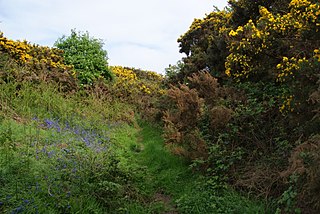
Castell Gwallter, also known as Walter's Castle and sometimes Castell Penweddig, is the remains of a Norman motte-and-bailey castle situated on a large hill above the old village of Llandre in northern Ceredigion, Wales, four miles northeast of Aberystwyth.
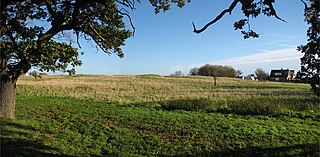
Woodwalton Castle was a small motte and bailey castle at Church End, the northern end of the parish of Woodwalton, Huntingdonshire. Located on a natural hillock, the earthworks of the castle still remain, with an outer moat enclosing a circular bailey with a central motte. A large dyke, apparently ancient, runs from the outer moat in a north-easterly direction. The site is a scheduled monument.

Lidgate Castle is a medieval motte and bailey castle in the village of Lidgate, Suffolk, England, built to an unusual quadrangular design.

Rampton Castle, known locally as Giant's Hill, is the earthwork remains of a motte and bailey castle in Rampton, Cambridgeshire. It is believed that the castle was constructed during The Anarchy by the forces of King Stephen to contain the revolt of Geoffrey de Mandeville. The castle was not completed; construction was probably halted by de Mandeville's death at nearby Burwell Castle in 1144. Sited near to the churchyard of All Saints' Church, the castle is thought to have been built over the eastern end of the medieval village.

Bossiney Castle is a Norman fortification, built in the 11th century, following the Norman invasion of England in 1066. It is in the village of Bossiney, in North Cornwall The remains of the motte are on private land with no public access, but can be viewed from the B3263, lying behind the 19th-century Methodist Chapel.

Llanthomas Castle Mound was built by the Normans after the 1066 Norman conquest of England but before 1215. It is a first-generation motte and bailey castle design; the building materials were earth and timber.
Weston Turville Castle is a motte-and-bailey in Buckinghamshire, England. It consists of a mound with two enclosures (baileys). The castle was built in the 11th or 12th century and first mentioned in 1145. It was held by Geoffrey de Turville in 1173–74 when it was demolished (slighted) on the instructions of Henry II.

Castle Knob, also known as Castle Gresley castle is a motte and bailey castle in Derbyshire, England. The date of construction is not known but may date to the mid-12th century Anarchy era. The site was long under the ownership of the de Gresley family. The castle survives as earthworks including a 4 metres (13 ft) high motte and three baileys, the largest measuring 70 metres (230 ft) across. The site had been abandoned by the 16th century and, in the mid-20th century, the Royal Observer Corps (ROC) installed a nuclear warfare monitoring post in the central bailey. The site became a scheduled monument in 1966.
References
- ↑ "The Project Gutenberg eBook of The Chronicle of Jocelin of Brakelond: A Picture of Monastic Life in the Days of Abbot Samson, by Jocelin de Brakelond". www.gutenberg.org. p. 255. Retrieved 4 November 2024.
- ↑ "Milden Castle (The Gatehouse Record)". www.gatehouse-gazetteer.info. Retrieved 4 November 2024.
- ↑ Historic England. "Mound of Milden Castle (1006016)". National Heritage List for England . Retrieved 17 June 2021.